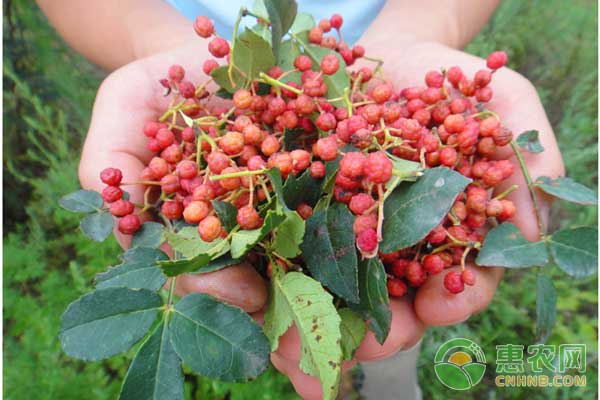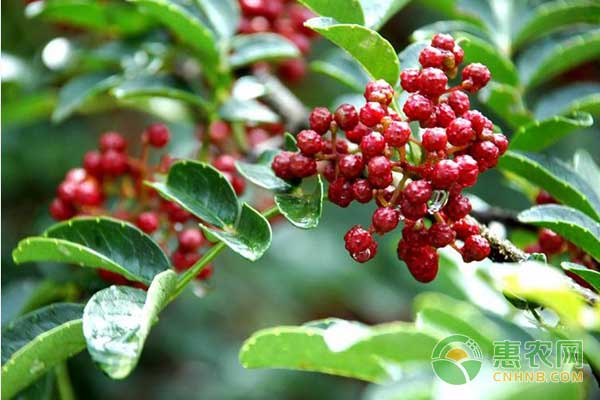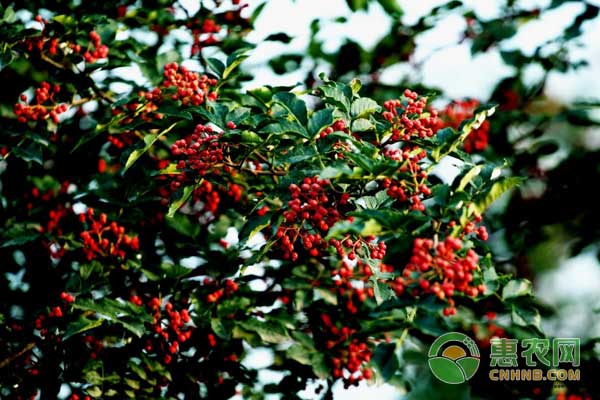Dahongpao pepper is an excellent variety of pepper in China with a wide distribution and the largest cultivation area. Dahongpao pepper has strong tree, compact tree shape, rapid growth, high yield and stable yield. Its dry products have strong taste and excellent quality, suitable for 300 meters above sea level. It is cultivated on sandy loam of 1,800 meters, moist and deep and moist. First, growth habits Dahongpao has the characteristics of high yield, high yield and stable yield, and is more resistant to drought and cold resistance. It is suitable for cultivation in warmer climate regions. The phenological period of Dahongpao pepper varies depending on the variety, distribution area, altitude and climatic conditions. Dahongpao pepper has a total growth period of 210~220d. 1, germination and shoot When the temperature in spring stabilizes through 30 °C (in late March), the pepper begins to germinate and germinate; when it passes through 5 °C, it will germinate a lot (in early April), and it needs ≥0 °C accumulated temperature 140 °C ~ 160 °C.d, stable through 10 °C (4 In the middle and late months of the month, germination and new shoots are started, and the germination leaves need ≥0 °C accumulated temperature of 150 °C ~ 160 °C.d. 2, flowering period The flower inflorescences are born on the top of the new shoots, and the buds begin to appear 5 to 7 days after the leaves are spread. The average daily temperature is stable through 12 °C, the inflorescence grows fast when the daytime temperature is 15-20 °C, and the flowering period is in the late buds in late April; the temperature in early May is stable through 15 °C into the flowering period; the flowering period needs ≥0 °C accumulated temperature 240~ 270 ° C.d. The flowering of the pepper tree is opened from the base of the inflorescence to the top, and the whole flowering period is closely related to temperature and humidity. The average daily temperature is 20 °C, and the relative humidity is about 70%. It is most suitable when it is lower than 15 °C or higher than 27 °C. When the humidity is too large, the viscous substance secreted at the top of the flower bud also inhibits flowering; the flowering period is even rainy or continuous for many days. Excessive humidity can cause the flower buds to be rotted; if the humidity is too small, drought or wind, the stigma will dry up and shrink, thus affecting fertilization and fertilization. 3. Fruit and fruit expansion period After 6-10 days of pollination, the ovary gradually expands into the fruit seat period in late May, and the fruiting period needs to be ≥0 °C accumulated temperature 320-340 ° C.d; from early June to early July into the fruit expansion period, daily average The temperature is about 20 °C is most suitable; the fruit expansion period needs ≥0 °C accumulated temperature 770 ~ 800 ° C.d, light 400 ~ 500h. The growth of the fruit is inhibited below 150 ° C or above 30 ° C. The fruit setting period is the main period of physiological fruit drop and is closely related to climate and water and fertilizer management conditions. 4, fruit coloring period In the end of July, the fruit is colored. Need higher temperatures, plenty of light and some precipitation. The coloring period needs to be ≥0 °C accumulated temperature 1050 ~ 1200 ° C.d. Too much sunshine and too much rainfall will affect the synthesis of photosynthesis and organic matter, resulting in fruit drop and reduced production. If the number of days with a temperature greater than 35 °C is too low, the color of the fruit will be light and the quality will be poor. 5. Fruit ripening period Before and after the operation of the pepper, the fruit ripening period (in the middle and late August) requires an accumulated temperature of ≥0 °C of 150-160 ° C.d. When ripe, the skin is purple-red and the seeds are black. The rainy weather during the ripe harvest period will cause the color of the pepper and the poor taste to affect the quality. Excessive rainfall after harvesting will prolong the growth period of new shoots and defoliation, resulting in low degree of lignification and freezing damage in winter. Early weather will cause early defoliation, and warm autumn and rain will cause secondary germination and flowering to affect the growth and yield in the coming year. 6, wintering period The pepper tree grows until the end of autumn and winter. When the temperature drops to about 3 °C (November), the growth stops, and the petiole forms a separation layer, which enters the deciduous dormant wintering period. When there are more warm winter days above 3 °C, the life activity of the pepper tree is relatively strong, the breathing is accelerated, and the nutrient consumption is increased, which affects the growth and development in the coming year. Second, the climate ecological conditions 1, temperature Zanthoxylum is a positive temperature-sensitive tree species with an average annual temperature of 10-14 ° C and ≥ 0 ° C. The annual accumulated temperature is 3005-3245 ° C.d. The growth and development are good, the fruit is normal, the color taste is good, the maturity is sufficient, and the yield is high. . The resistance of pepper to cold is strong. In winter, the accumulated temperature below 0 °C can be safely overwinter within -400 °C.d. Single saplings and old trees are poor. Young trees can withstand low temperatures of -18 to -20 °C, and trees can be resistant for more than 10 years. At a low temperature of 20 to -23 ° C, when the temperature drops to -25 ° C, the tree species will be killed by freezing. 2, precipitation Zanthoxylum bungeanum is a drought-tolerant tree species. The annual precipitation is more than 400mm, which can be normally developed and sturdy. The optimum precipitation is 500-800mm. Drying can cause a large number of fallen flowers and fruits. The excessive precipitation makes the roots in anaerobic respiration and grow poor or die. The total water requirement is more in the early and middle stages, and less in the later stage, especially when the coloring is mature; otherwise, the yield and quality will be affected. Moisture has a great influence on the yield. Drying in the early years can increase the yield, and irrigation should be in the fruit expansion period. 3, lighting Zanthoxylum is a species of hi-light, requiring annual sunshine hours of 1800-2000h. Especially in July-August, the ripening period of pepper coloring is the key period to ensure the yield and quality. Ample light is conducive to the accumulation of photosynthetic products, which promotes the thickening of the peel, the increase of yield, the coloration is good, the quality is improved; the light is not enough, the color of the pepper is dim, the quality Decline or even mold. The peppers that have been growing for a long time or growing on the shady slopes are also poorly sturdy due to insufficient light, and the yield and quality are poor. 4. Soil Zanthoxylum bungeanum is a straight root plant with more roots and roots. Neutral loam or sandy soil with deep soil and loose soil can grow normally in calcareous or slightly alkaline soil. It is resistant to thinness and is suitable for planting on the “four sides†where the terrain is gentle and the light is sufficient and there is no water. The slope of the hillside is 5-20°, which is the planting section. The slopeland can be gradually built into terraces and scale pits for water retention, fertilizer conservation and soil conservation. It is not appropriate to plant in low terrain. 5, the wind Pepper is a well-ventilated environment, and the breeze can promote pollination. It is best to avoid strong winds. It is not suitable for planting at the tuyere or in windy areas. It is necessary to choose hilly land, depressions and roadsides on the leeward or sunny slopes as the most suitable development zone for pepper. Third, cultivation technical specifications (1) Selection 1. Choosing the seeding tree: The selected mother tree must be a fruit tree that grows strong, is strong, has high yield, stable yield, good quality, and no pests and diseases. It is usually 10 to 15 years old. 2, seed collection: When the fruit skin is all dark red, the seed coat turns blue and black, when it is bright, it can be harvested. Usually harvested in early August. After harvesting, the pepper is thinly spread on a layer for drying. When the peel is cracked, gently tap the wooden stick to collect the seeds, and place them in a dry and ventilated place for drying. (2) Nursery 1. Sowing time: before and after the soil is frozen in October. The seeds are overwintered in the soil, which not only plays a role in germination but also eliminates the seed storage process during wintering, and is tidy than the spring seedlings, and emerges 10 to 15 days earlier. 2. Seeding method: In the whole tweezers (1m wide and 5~10m long), the water-selected seeds are evenly spread on the surface of the clam, and then the fine soil is 1cm thick, and the straw is kept. The seedbed is moist, and then removed after emergence. The selected seeds are about 30kg per acre. 3, seedling management: weeding should be carried out in time after emergence, to prevent grass shortage to facilitate seedling growth. When the seedlings are as high as 4 to 5 cm, and there are 3 to 4 true leaves, the seedlings are carried out. When the seedling height is about 10cm, the seedlings will be fixed, and about 30,000 plants will be kept per mu. In the seedling stage, timely irrigation should be carried out, and 5 to 10 kg of urea should be applied per mu in combination with irrigation. Fertilizer should be controlled and water control should be carried out in the later stage of growth. When there is too much rain, the seedlings will be chemically controlled for the sake of lignification and safe wintering. (3) Planting 1. Planting density: (1) When the terraced mantle and the field side are planted in a single row, the plant spacing is 3 to 4 m. (2) Whole planting, 50-80 plants per acre, 3×4m, 3×3.5m, 2.5×4m. (3) Eco-economic forest planting, 110 plants per mu, with a row spacing of 2×3m. 2, planting time: (1) Planting in autumn and winter after defoliation until the soil is frozen and paying attention to anti-freezing. (2) Planting in spring: after the soil is thawed and before germination. (4) Management 1. Plastic pruning: The main high-yield tree shape is the main shape of the trunk. The tree shape fully utilizes the biological characteristics of the pepper tree, and has the advantages of rapid forming, early result, ventilation and light transmission, resistance to diseases and insect pests, and high yield. After planting, it is dried at a full bud from 30 to 40 cm from the surface. In the second year, for the 3 to 4 main branches selected, use the method of pulling and other methods to open the angle, and then remove the original remaining auxiliary branches. In the third year of spring, the branches of 50 cm or more were cut by 1/3, that is, a large amount of flower buds were formed. 2. Reasonable fertilization: (1) Base fertilizer: It is best to apply the base fertilizer in the autumn after picking the pepper. (2) Topdressing: Generally, the topdressing is twice in a year. For the first time, before the budding, the nitrogen fertilizer was mainly used and the phosphate fertilizer was properly matched. For the second time, phosphorus and potassium fertilizers were mainly used from the end of May to the beginning of June. (3) Fertilization method: The saplings are best in a ring shape and a radial groove shape. Shengguoshu is suitable for the whole garden to apply for deep turning or point-like acupoints. 3. Pest control: Zanthoxylum bunge is mainly used to control aphids, scale insects, narrow gibberella, mites, red spiders and anthracnose. (1) Aphids: Adhere to the principle of “prevention of early prevention, prevention of small, timely detection, and timely prevention and controlâ€, focusing on prevention and control of pre-flowering, post-flowering and flowering, in order to ensure production, and select imidacloprid and methomyl pesticides. (2) Scale insects: focus on the prevention and control of spring before germination and the prevention and control of the first instar (from the end of May to the beginning of July), and the use of Swiss-made speed culling can be used for prevention and control. (3) Narrow Gypsophila: The main glue flow site is treated by hammering or applying 50 times of omethoate. (4) Loose leaf jumper: spray 50-100 times of phoxim or sprinkle carbofuran granules in spring to prevent wintering adults. (5) Red spider: From late May to early June, combined with other pest control, mixed spray "avermectin" for prevention and control. (6) Anthrax: Spraying 800 times of the first and second times in the initial fruiting and coloring stages for prevention and treatment. (5) Harvesting When the pepper bulge on the reddish fruit of the fruit is translucent, the seed is completely black and mature. At this time, the harvest is carried out in the order of “first sunny slope and backward male slopeâ€. At the time of harvesting, the artificial hand picking method is mainly used to protect the oil bubbles, so that the color does not change after drying, does not affect the quality, and does not reduce the value of the commodity. (6) Drying Natural drying is generally used. The collected peppers are immediately spread out on the plots or mats in the sun. Generally, it should be dried for 3 to 4 hours. Use a wooden stick to gently flip it. In the rainy weather, artificial indoor drying is adopted. After drying, the peel and seeds are separated to remove impurities, bagged according to the grade of the variety, and sealed and stored. (7) Preservation The dried pepper fruit is classified, and if it is not sold for a while, it is put into a new woven bag. Double-layer packaging, that is, a plastic bag (must be polyethylene) is placed in the woven bag, which is hygienic, moisture-proof and difficult to color and run. After the installation, the woven bag mouth is folded and stitched tightly, and the label is attached with a label indicating the weight and grade. Care should be taken to keep it in a cool, dry room. It is strictly forbidden to mix with pesticides and fertilizers. The above is the growth habits and cultivation techniques of Dahongpao pepper, I hope to help you. If you want to know more about agricultural technology, please pay attention to the Hui Nong School! Both IgM and IgG are immunoglobulin which are produced by the immune system to provide protectionagainst the 2019-nCoV. Some patients with negative results in nucleic acid test show positive in IgM test,indicating that the IgG / IgM detection is one of the effective methods for the diagnosis of 2019-nCoV. Office Testing Kit NINGBO AUTRENDS INTERNATIONAL TRADE CO., LTD , https://www.metests.com


Introduction and cultivation techniques of Dahongpao pepper growth habits
Prev Article
What do you eat in the spring?